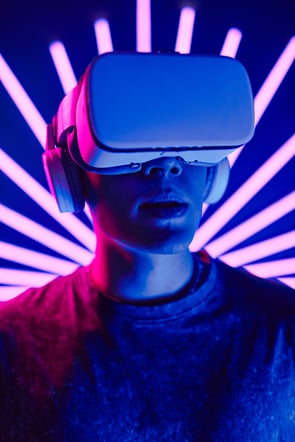Blog
2024 Marketing Trends
No one can predict the future — but marketers sure like to try. As we approach the end of the calendar year, we’re all thinking about how to successfully market brands in the future, from in-person experiences to digital advertising campaigns.
Marketing trends shifted drastically during the COVID-19 pandemic, and they continue to evolve at a rapid pace today. While constant change prompts marketing professionals to re-evaluate their own strategies and campaigns often, it also presents an exciting opportunity to adopt emerging trends.
There is power in marketing, and following data and trends allows your business to be successful. When you market your brand using emerging technologies and escalating trends, you’re much more likely to connect meaningfully with your target audience. Just as importantly, marketers must leave certain strategies behind, even if they were successful in the past. A willingness to adapt and evolve based on KPIs and data points is the cornerstone of marketing success.
Before you worry about throwing all of this year’s strategy out the window, here’s the good news: many of this year’s trends are projected to stick around in 2024. We’ve done the research and compiled a list of which trends are going strong and which new ones you might want to consider in the year ahead.
Lasting Trends from 2023
As we studied our list of 2023 marketing trends and compared it to the projected 2024 trends, four things stood out to us. Chances are, you’re already incorporating a few of these strategies into your marketing efforts. If so, keep up the good work — and if not, it’s not too late to start, since they’ll keep making a splash in 2024!
1. Interactive AI
In the digital age, we’re all used to getting answers quickly — and this is true for consumers across the board. Interactive AI is cutting down wait times for online consumers by employing AI chatbots or virtual assistants to provide instant assistance with common issues or answer frequently asked questions.
According to Business Wire, consumers are prioritizing a fast shopping experience over fast shipping times — a surprising stat, but one that interactive AI can help brands capitalize on. Using artificial intelligence to help potential shoppers make a purchase can boost a business’s bottom line significantly. While “return to cart” email campaigns and similar tools are still important, brands that focus on making the sale before customers click away are projected to experience the highest rates of success.
2. AR and VR marketing
Virtual reality continues to grow year over year, creating simulated experiences that immerse audiences in a new perspective. As we discussed last year, many brands are using VR technology to show customers the kind of impact their purchases will have, from TOMS’ Virtual Giving Tour, designed to show customers where their charitable gifts land, to Marriott’s VR event planning tool that helps event planners configure a space even before they travel to it.
immerse audiences in a new perspective. As we discussed last year, many brands are using VR technology to show customers the kind of impact their purchases will have, from TOMS’ Virtual Giving Tour, designed to show customers where their charitable gifts land, to Marriott’s VR event planning tool that helps event planners configure a space even before they travel to it.
This year, consider adding AR marketing into your digital strategy. While virtual reality replaces your real environment with a simulation, augmented reality works with your current environment by adding in digital elements. Just how are companies using AR marketing, you ask? The solutions are as unique as the brands that crafted them.
Studio Lucasfilm created an AR app during their promotional campaigns for The Mandalorian on Disney+, allowing fans to visualize characters in their own homes and even reenact popular scenes. Malibu Rum created billboards that turned into interactive games when scanned through the Snapchat app. And retail brands like Nike, Sephora, and Ray-Ban have all incorporated AR technology into their virtual try-ons, allowing customers to “try on” lipstick, shoes, or shades before adding to cart – without leaving home.
3. DEI Focus
Customers continue to support brands who promote Diversity, Equity, and Inclusion (DEI) in their marketing — and back it up with inclusive practices internally and externally. A study conducted in 2023 demonstrated that up to 61% of customers would be willing to switch brands or choose a white-labeled product if that company aligned with their values.
This is an excellent opportunity for marketers to highlight diversity and inclusion in their companies, showing customers that they’re working for equality and ethically sound business practices. If you haven’t already incorporated DEI efforts into your marketing strategies, 2024 is a great time to start.
 4. Video Advertising
4. Video Advertising
There are many elements to a successful marketing campaign, but video is quickly becoming a cornerstone piece. 93% of marketing professionals included video in their marketing strategy this year, and there are no signs that this trend is slowing down in 2024. The best news? Video is an effective tool across the board, from high-production video ads to smartphone videos from real customers.
Three 2024 Marketing Trends to Watch
Even with the solid foundation of 2023’s top marketing strategies, we’re all looking to build in some new trends, too. We’re keeping our eye on these three — they just might fit perfectly into your future strategies to hit your KPIs, grow your customer base, and solidify your brand’s relevance in 2024.
1. Contextual advertising
Many brands are shifting their approach to targeted advertising, moving from location and demographic info to more personalized options. Contextual advertising takes a viewer’s preferences into account by showing relevant ads based on the content they view frequently (or are viewing at the current moment!)
To make this strategy crystal clear, here’s how it works. Let’s say you’re searching online for a new dining room table. Instead of the banner ads on the site being for supplements or Christmas lights, you’ll see ads for dining room rugs or chandeliers. This strategy can also be personalized even further. For example, if you consistently buy vanilla lattes from your favorite coffee shop, you may receive an offer for 25% off your next vanilla latte, instead of a generic 25% off “any item” coupon.
By offering customers ads and offers that are tailored to their preferences and viewing habits, you can build brand loyalty and boost sales.
2. Personalization
Personalization has taken the marketing world by storm in recent years, and it proves to be the strategy of the future. You’re likely already familiar with personalization in marketing, so we wanted to zoom out and discuss how to make this popular strategy effective in 2024 by avoiding common mistakes.
Personalized product recommendations, emails, and offers are excellent tools to coax audience members into becoming actual customers. However, it’s important to balance personalization with privacy — a growing concern for audiences (and therefore brands) everywhere. When customers feel as though a brand knows too much about them, it can damage their perception of the brand and make them less likely to buy or engage.
It’s also important to clarify which data points have been personalized with success in past campaigns and stick to those. There are endless ways to personalize marketing, but employing too many tactics can result in a disjointed and ineffective strategy. Remember, the end goal of your campaign isn’t to personalize everything; it’s to connect with your audience.
3. First party data
Even as contextual ads and personalizations are on the rise, brands are learning how to engage with consumers without crossing boundaries. Many browsers are limiting cookie usage, which marks the pivot from third-party gathering to first-party data.
Fast Company reports, “For advertisers that have invested in developing subscription offerings, newsletters, and tools to collect consumer data and build sophisticated content taxonomies to deliver meaningful contextual offerings, 2024 will be the year these investments pay off in spades.” Even if you haven’t been gathering robust consumer data in the past, 2024 is the time to start. It will absolutely inform your marketing efforts in the future.
The Future of Marketing
The future of marketing seems increasingly digitized — and in some ways, it is. However, marketers must always remember that the end goal of marketing your brand is human connection. Forbes has dubbed 2024 “The Year of Authenticity” in marketing, and at Redstory, we completely agree.
Consumers are growing more savvy about marketing efforts with every passing year, so they’ll definitely be able to sniff out which brands are genuinely hoping to connect with them and which are only concerned with the bottom line. Perhaps this quote says it best: “In a world obsessed with digitization, the authenticity of a smile, the warmth of a handshake, and the genuine empathy in a conversation become invaluable. Brands that recognize and act upon this intrinsic human need will create deeper, more meaningful connections with their audience.”
At Redstory, we’ve always been focused on the power of human experiences, from digital campaigns to experiential events. Want to take your marketing to the next level while remaining true to the interpersonal connection we all seek? We’d love to help..png?width=8000&height=4500&name=Redstory%20Blog%20(2).png)